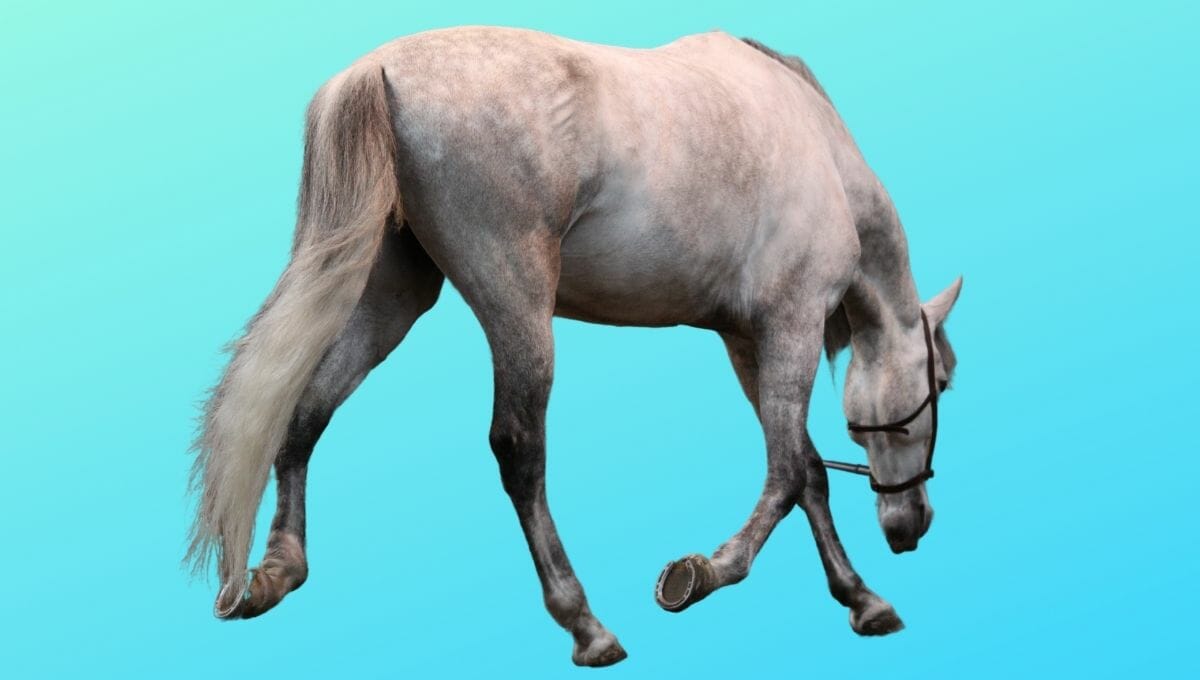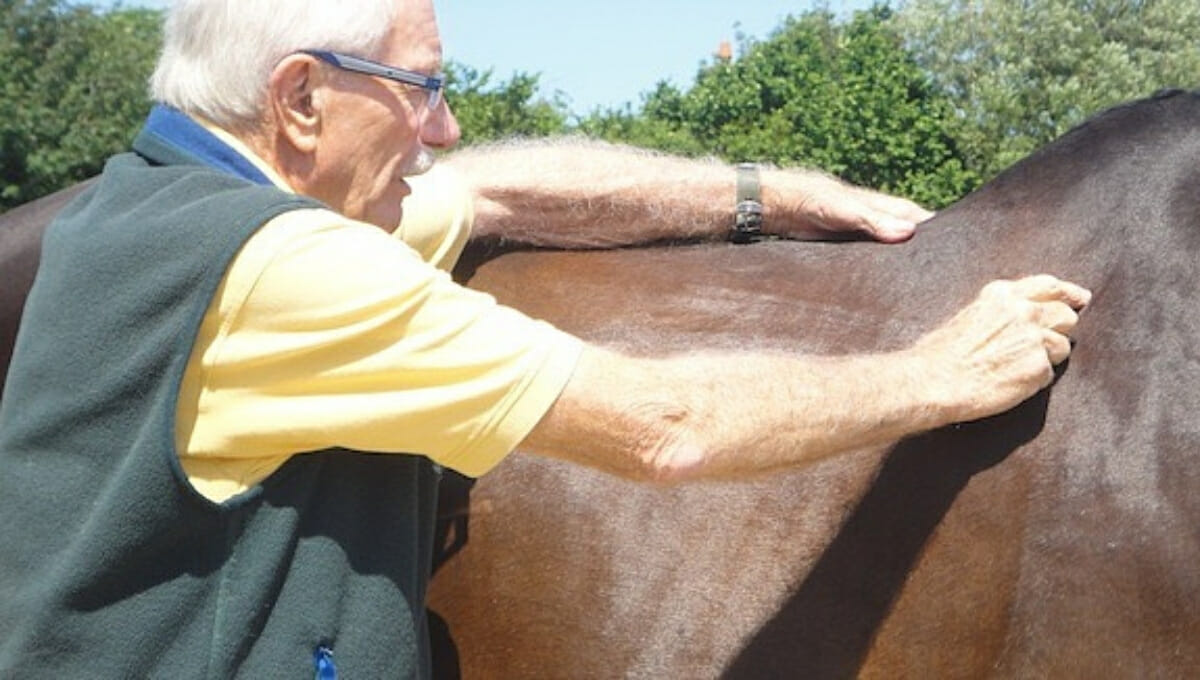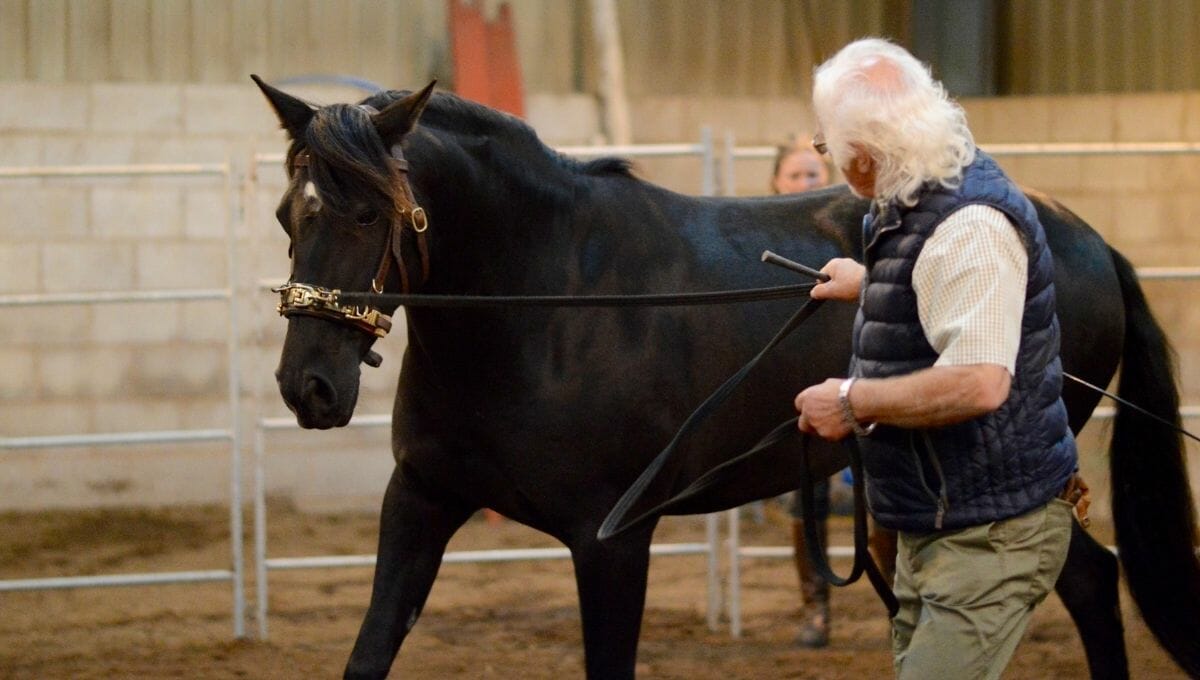Understanding horse posture is crucial to long-term soundness. Specifically, this relates to the manifestations of laterality seen in horses. Understanding this topic will help to start the journey in correcting the crooked horse.
Starting to identify whether your horse is right or left forelimb dominant will affect horse posture, functional movement and horse straightness. In this article, discussing the thoughts and approach of the late Dr Kerry Ridgway, you will learn about functional movement and the way laterality (right or left fore limbed horses) can conspire against the ridden horse.
Understanding the “crooked horse syndrome,” is, in my opinion, absolutely critical to every horse’s well being, performance ability and long range soundness.
Dr Kerry Ridgway DVM
Who was Dr Kerry Ridgway?
Dr Kerry Ridgway worked both as a veterinary clinician and as an educator regarding laterality expressed as the“crooked horse syndrome. Through client and horseman education, it was his goal to prevent and avoid so very many of the musculoskeletal problems that he encountered day in and day out. he was skilled in both chiropractic and acupuncture treatment on horses.
Dr Ridgway wanted to get the horse-owning public to understand the manifestations of laterality and how to bring the horse into balance and straightness. For Forageplus this is an important message for it is such an enormous key to horse soundness and eliminating the musculoskeletal problems which plague our ridden horses.
At lectures he presented for Forageplus at Reaseheath College in Cheshire, Dr Ridgway presented the evidence for 75 to 80 percent of all horses being right forelimb supporting dominant, while the remaining horses are left forelimb supporting dominant.
Why is understanding horse posture important?
Since Xenophon, every riding master, expert trainer, and the deepest thinking riders have recognized that all horses start with a difficult side to their bodies – a hollow side and a convex side. Most remain this way for their entire lives. They exist within the context of the “Crooked Horse Syndrome.”
These inherent aspects create the biomechanics of movement and the posture of the “natural horse.” Such biomechanics serve the horse well in its natural wild/feral state but are antagonistic to those required of the ridden horse. Because of this dichotomy, many techniques are utilized to “straighten” the horse. The essence and purpose of all the techniques are to minimize limb dominance and create/develop the biomechanics and horse posture necessary for riding horses. The end goal is always to make them more ambidextrous and strong over their top line.
Failure to achieve ambidexterity, balance and straightness creates problems in performance, a shorter useful life and eventually leads to unsoundness.
Dr Kerry Ridgway DVM
How can we help the crooked horse?
The “Crooked Horse Syndrome” is part and parcel of the genetic quality called “Laterality.” Laterality always affects horse posture. Laterality is expressed as a “dominance” of one side of the body (associated with brain laterality). This is expressed, in common language, as being “right” or left-handed.” We have carried this handedness terminology over to the horse. Dr Ridgway did, however, think that the term “right” or “left-handed” is inappropriate and leads to confusion. Humans are bipeds and horses are quadrupeds, different biomechanics come into play and the limbs are not used for the same functions.
How to use terms to explain the crooked horse
So then, how did Dr Ridgway define the terms? He asked:
- Are we attempting to determine which limbs and which side of the body are more in control of movement? Have we confirmed which side of the equine brain is dominant (in terms of Laterality)?
- What role do muscles play in Laterality?
- What muscle actions create more ease of movement in one direction verses the other?
- When we use the term “dominance,” are we referring to use of muscles as more supporting, more balancing, or stronger in propulsion?
- Are the muscles, in a given limb facilitating – stabilizing or mobilizing?
It matters not, whether you are a rider (pleasure or performance), a trainer, a veterinarian (conventional or integrative medicine oriented), a groom, a farrier/trimmer or a massage/physiotherapist, nearly every musculo-skeletal injury or pathology that we identify and attempt to cure or manage is related to the “Crooked Horse Syndrome.
Dr Kerry Ridgway DVM
Why does limb dominance affect horse posture?
Dr Ridgway believed that dominance of a front limb might require a shift in definition as we moved from the bipedal human to the quadrupedal equine. But, by placing the human in a quadrupedal position, he demonstrated that we could still use the human as an example of a change in what we are calling“limb dominance.”
His interest, initially, became piqued when Martina Steinmetz, a German Veterinary acupuncturist presented some acupuncture aspects of laterality at an International Veterinary Acupuncture Congress. Later, he got together with her and had discussions about the asymmetry of horse hooves in the “high/low” syndrome. This was a favourite topic of his.
He identified that this limb dominance led to compromises in movement patterns resulting from laterality. Laterality led to the development of compensatory muscle and problems with the fascia. Tension in muscles and fascia often led to pain and hypertonicity on the dominant side of the body. Once these patterns and compensatory movement became embedded in the ridden horse soundness issues always seemed to follow.
Confusion and disagreement about the role of laterality led him and his wife Christine to research more of what is known about equine laterality, functional horse movement and “straightness training.” They extensively studied and discussed various material. They read and dissected the Schoeneich book, “Correct Movement in Horses” many times over. This led to them travelling to Germany to meet and spend time with both Klaus and Gabriele Schoeneich.
What did Dr Ridgway learn from the Schoeneichs?
As a rider and trainer, Klaus has been involved in “straightness training” with horses for nearly 30 years and has developed and used his system of training on approximately 6000 horses. Dr Ridgway and Christine were captivated by the concepts that he expressed. Those concepts have enormous significance not only to riders but very importantly, to the pathology that Dr Ridgway and every veterinarian observe the day in and day out.
Dr Ridgway and his wife watched many horses improve in balance, and consequentially, in soundness, within the short span of the two weeks they spent with the Schoeneichs. They had the opportunity to do physical examinations on these horses every couple of days and saw reductions in the muscle pain and hypertension of given muscles.
How does straightness training improve horse musculoskeletal problems?
This experience changed the entire focus of Dr Ridgway’s veterinary medical practice. For several years, he had observed that every horse he examined from a musculoskeletal perspective, had identical patterns of muscle hypertension and pain upon palpation. This was true regardless of discipline or use of the horse, 75 to 80 percent of the time the pattern was consistent between every horse.
The other 20 to 25 percent exhibited the same pattern, but in a mirror image. (There might be relationships of muscle size (hypertrophy and tone) according to use, but the “pain” and “tension” issues were, essentially, within the same sets of muscles in all cases. This is related to how the horse used the same muscles to a different degree on one side of the body versus the other side.
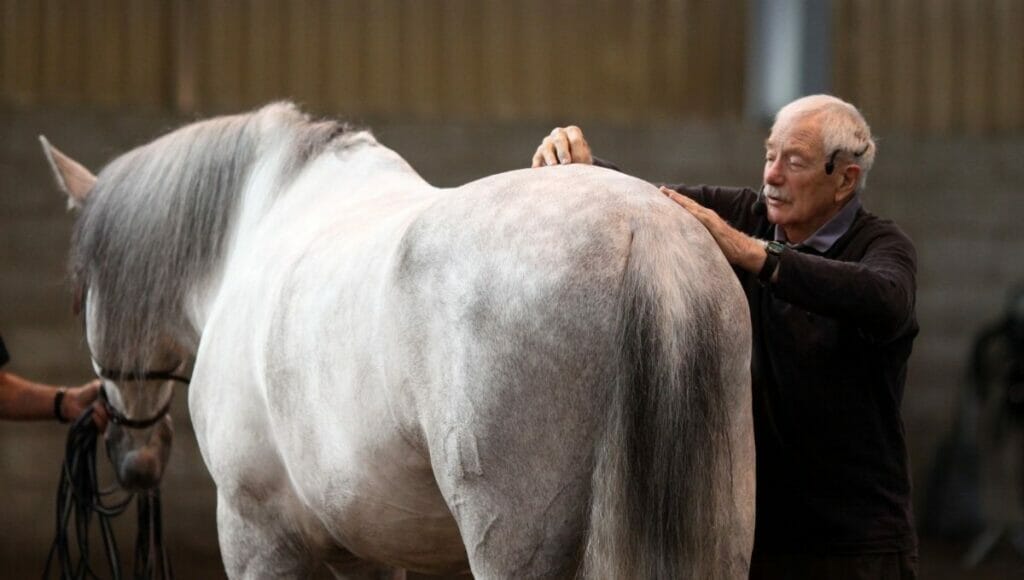
What are the signs that horse posture is affected by laterality?
Klaus Schoeneich describes 75 to 80 percent of the horses as being right forelimb dominant. These horses are described by Klaus and several other highly respected trainers, veterinarians, and others studying biomechanics, as being “right forelimb dominant.” Most commonly, the left side is the hollow side, – the right side being convex. In this instance where the right forelimb is dominant then the following are easily observed and experienced:
- Typically most horses, when being started, have an easier time picking up a left lead than the right lead.
- When starting a young horse it will respond better to the left rein and be resistant to the right rein.
- When lunging the horse to the left most horses “pop out” the right shoulder and exhibit the effects of centrifugal force – thus they keep widening the circle.
- The same young horse who is being started is reluctant to lunge to the right and will often stop and turn towards the trainer.
What happens to the muscles of a horse which is crooked?
Regarding muscles … Dr Ridgway often, facetiously, referred to them as “not the brightest bulb on the tree.” By that, he meant that muscle physiology is based on a polarizing stimulation for contraction followed by depolarization and release. The release part does not occur in the case of overuse, “over facing” muscle(s) by certain overly strenuous movement(s), or by extensive repetitive use of specific muscles – i.e. cumulative micro-trauma. (As a metaphor, think of carpal tunnel syndrome in the human.) These muscles in our “crooked horse” remain in a chronically contracted state and set up markedly reactive points, i.e. acupuncture points (latent and active), as well as trigger points. Prolonged contraction sets up a state of chronic pathology.
Dr Ridgway found that the majority of horses, 75-80%, who have not been trained for ambidexterity, have pain and hypertension in the neck muscles on the right side, but not on the left side. Presumably, the severity of this pain will dictate whether gait abnormality or other compensations result ultimately in lameness. The shoulders will be affected on the right side.
Interestingly these are the same sets of muscles that get more painful or damaged from overuse in a “right-handed” human/biped. Muscles only get to this state if they are the more used (and abused) set. They have progressed from “tone” to a state of “hypertonicity.”
If we are recognizing heavier muscle use present on the right shoulder and forelimb we can logically describe this as a “muscle dominance” or right forelimb muscle dominance.
Dominance, support, balance, and propulsion also are important in a proper evaluation of how we define laterality. So, when Dr. Ridgway assessed the right hindquarters in a “right forelimb dominant” horse, he would find certain muscles which were used as a base of support and balance – both in the stance phase and during movement. These muscles would be very tense and reactive to palpation. Examination and evaluation of the left hindquarters revealed quite different muscle tension patterns with the hamstring often being painful and in tension.
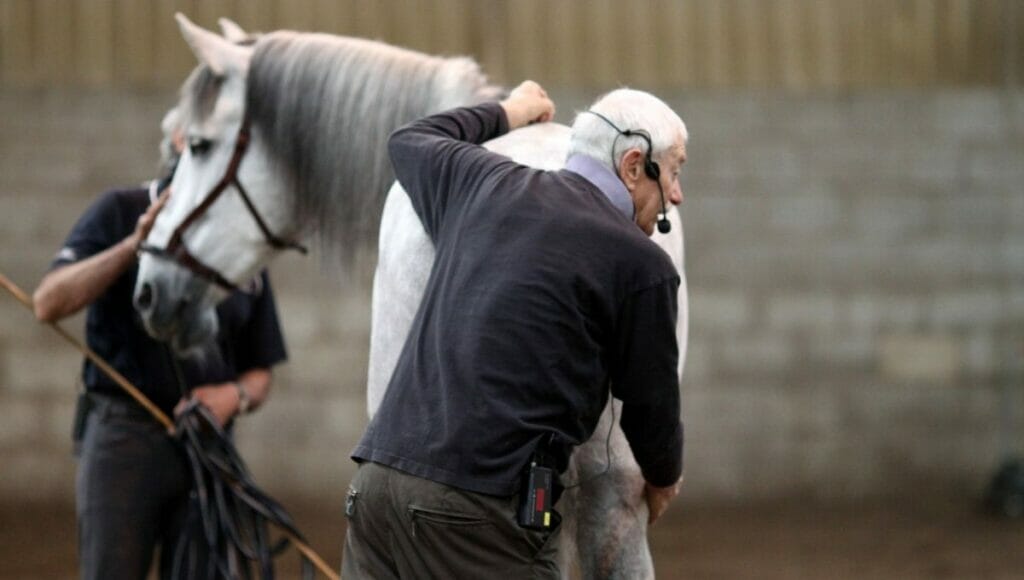
How does horse posture change other aspects of the horse’s body?
The horse evolved as a grazing animal, designed to place more of its weight on the forehand to facilitate grazing. The way laterality and horse posture is expressed, and then remains unaddressed when the horse is under saddle, will dictate the way the body responds over time with skeletal and muscular imbalances.
Typically, the RF foot is more upright and takes a more forceful concussion, evidenced by a higher incidence of suspensory and check ligament injuries on the RF. This also correlates with the shortened stride of a weighted shoulder.
The left front hoof often has a long toe with a low and under-run heel. These horses are often lower in the left heel. This limb is more subject to navicular issues and injuries to the impar ligament, distal sesmoidean ligaments, deep digital flexor insertion on P-3, and upper forelimb tendon injuries than the more upright right forelimb. There is more too! Sacroiliac problems are more evident on the right and the facet joints of the thoracic and lumbar vertebrae exhibit more pathology on the right side of the horse of the right forelimb dominant horse.
Why understand the implications of horse laterality?
The implications of horse posture and the manifestations of laterality are huge for all horses at all levels of competition, in all aspects of their role as ridden leisure horses. This is whether they are happy hacker types or FEI performance horses.
Dr. Ridgway understood how to assess, monitor, and help create balanced, straight horses, to reduce the implications of all that asymmetry and “the crooked horse syndrome” created.
Dr. Ridgway sadly passed away in January 2016 he will be missed by all of those throughout the world who loved him for his humble but magic touch with horses. If you want to read a tribute to him please click here.
Read more of our horse muscle-related articles here.

